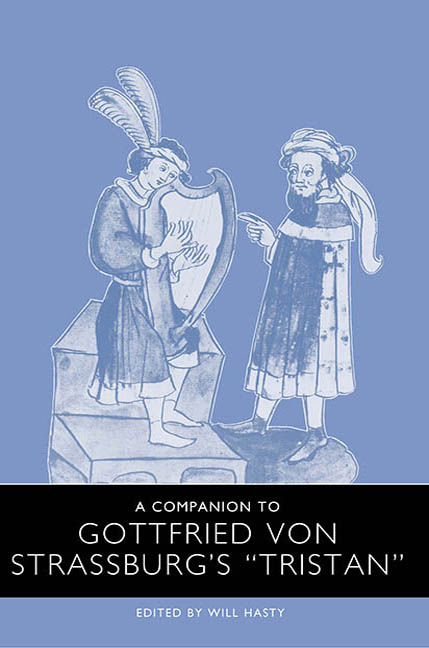Book contents
- Frontmatter
- Contents
- Acknowledgments
- Introduction: The Challenge of Gottfried's Tristan
- I Cultural and Social Contexts
- II Figures, Themes, Episodes
- Gottfried's Adaptation of the Story of Riwalin and Blanscheflur
- This Drink Will Be the Death of You: Interpreting the Love Potion in Gottfried's Tristan
- God, Religion, and Ambiguity in Tristan
- The Female Figures in Gottfried's Tristan and Isolde
- Performances of Love: Tristan and Isolde at Court
- Duplicity and Duplexity: The Isolde of the White Hands Sequence
- III Gottfried's Narrative Art
- IV The Medieval and Modern Reception of Gottfried's Tristan
- Notes on the Contributors
- Index
This Drink Will Be the Death of You: Interpreting the Love Potion in Gottfried's Tristan
from II - Figures, Themes, Episodes
Published online by Cambridge University Press: 28 April 2017
- Frontmatter
- Contents
- Acknowledgments
- Introduction: The Challenge of Gottfried's Tristan
- I Cultural and Social Contexts
- II Figures, Themes, Episodes
- Gottfried's Adaptation of the Story of Riwalin and Blanscheflur
- This Drink Will Be the Death of You: Interpreting the Love Potion in Gottfried's Tristan
- God, Religion, and Ambiguity in Tristan
- The Female Figures in Gottfried's Tristan and Isolde
- Performances of Love: Tristan and Isolde at Court
- Duplicity and Duplexity: The Isolde of the White Hands Sequence
- III Gottfried's Narrative Art
- IV The Medieval and Modern Reception of Gottfried's Tristan
- Notes on the Contributors
- Index
Summary
Why does the love potion, “this annoyance or irritation (Ärgernis) of Tristan-interpreters,” as Walter Haug calls it (1989, 607), deserve a separate chapter in this volume on Gottfried's Tristan? Haug answers by making the important point that the love potion by which Tristan and Isolde are inseparably joined to one another is one of the most controversial motifs of Tristan scholarship. Because of its central significance, the interpretation of the work may be determined to a considerable extent by the way it is viewed (1989, 575). But it is no easy task. There have been numerous attempts at interpretation over the years, and scholars have achieved no consensus. Nevertheless, the interpretation of the potion is so important that it cannot be overlooked.
Perhaps the simplest way of approaching the problem would be to see first of all what people in the Middle Ages thought about love potions, to look at them historically, and to see whether we can discover how they were made and used. Having done that, we can then look at the history of earlier versions of the Tristan and Isolde story, to see what they tell us about the love potion. After all, Gottfried knew other versions (Tristan 131–73; Hatto, 43 [all citations from Gottfried's Tristan are from the Krohn edition; all translations are from Hatto]) and generally rejects them in writing his story. What are the differences? Then, finally, we can survey briefly some typical ways in which scholars have viewed the love potion in Gottfried's Tristan. It will not be possible to go into great detail, for the literature is vast, but perhaps some general tendencies can be presented. We are fortunate to have excellent bibliographical aids for Tristan scholarship, and they should be mentioned prominently here: the studies of Steinhoff, Picozzi, Dietz, and Wetzel.
Love Potion History
Love potions are among the many medical remedies with a long history going back all the way into antiquity and even before that. The distinction between love potions, other medicines, and magical cures is not always clear. In fact, all three treatments, if one may indeed differentiate them, were directed towards ameliorating physical or mental (spiritual) conditions, be they infertility, sleeplessness, wounds received in battle, fever, madness, or other ailments (see the fourth chapter of Kieckhefer).
- Type
- Chapter
- Information
- A Companion to Gottfried von Strassburg's Tristan , pp. 87 - 112Publisher: Boydell & BrewerPrint publication year: 2003

